
|
U. S. CIVIL WAR
PHOTOGRAPHS
|

|
MONOCACY
(PAGE 1 OF 2)
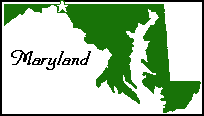
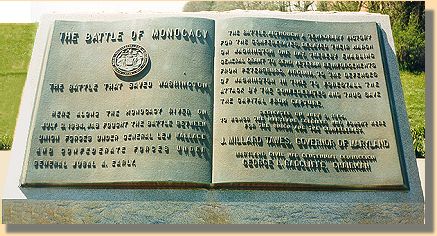
Monocacy Plaque (B)
In the text, the icon  is a link to the definition of the word it marks. is a link to the definition of the word it marks.
Use your browser's "back" button to return to this page.
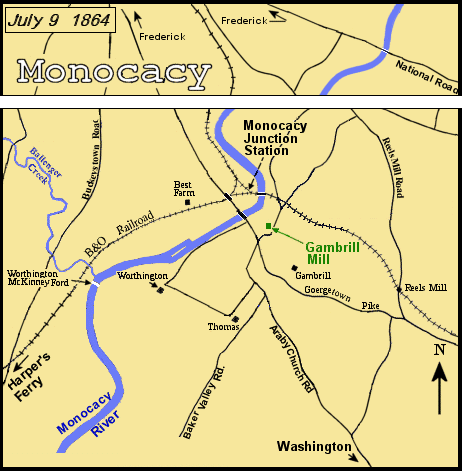
Monocacy Battlefield
| |
Date: July 9, 1864
Estimated Casualties : Approx. 2,100
total : Approx. 2,100
total
At the Battle of Monocacy, July 9, 1864, Confederate forces under Lieutenant
General Jubal A. Early defeated Union forces under Major General Lewis Wallace.
The battle cost Early a day's march, which, combined with other factors, cost him
his chance to capture Washington, DC. However, it should be noted that the main
purpose of Early's raid was to cause Union Forces to be diverted away from
General Robert E. Lee's army at Petersburg.
From that viewpoint, it was successful. at Petersburg.
From that viewpoint, it was successful.
THE ARMY OF THE VALLEY MOVES
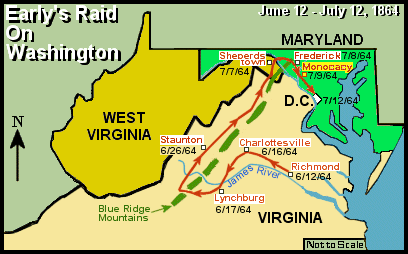
Leaving Richmond June 12, 1864, Confederate Lieutenant General Jubal A. Early's
Army of the Valley marched west to the Shenandoah Valley and then down the
Valley, crossing the Potomac River into Maryland at Sharpsburg, near Antietam. In
Maryland, they collected ransoms from Hagerstown, and Frederick as they passed
each town.
In response to Early's advance, General U.S. Grant sent a division of the VI Corps of the VI Corps , nearly 5,000 men, under Brigadier
General James B. Ricketts to Washington on July 6. Several days later Grant sent
the rest of VI Corps under General H.G. Wright to Washington. , nearly 5,000 men, under Brigadier
General James B. Ricketts to Washington on July 6. Several days later Grant sent
the rest of VI Corps under General H.G. Wright to Washington.
As Rickett's men began their trip north, the only Federal force between Early's
army, which was crossing the Potomac River at Sheperdstown, W.Va., and
Washington, D.C. was a group of 2,300 men commanded by Major General Lew Wallace.
When Wallace learned of Early's approaching army, he didn't know whether
Baltimore or Washington was the Confederates's objective. However, he knew he had
to delay their approach until Grant's reinforcements could arrive.
The location of Monocacy Junction, three miles southeast of Frederick, Maryland,
provided a point at which Wallace could delay Early's approach to either
Baltimore or Washington hopefully long enough for the Union re-enforcements to
arrive.
The Georgetown Pike to Washington, the National Road to Baltimore, and the
Baltimore and Ohio Railroad, all crossed the Monocacy River near Monocacy
Junction. Wallace intended to use his small force to protect these bridges and
fords, forcing Early into a time-consuming battle.
To Wallace's relief, by the time General Early's troops arrived at Monocacy, July
9, General Ricketts had already added his 5,000 Union veterans to Wallace's
forces and they were in place, guarding the fords and bridges across the river.
THE BATTLE
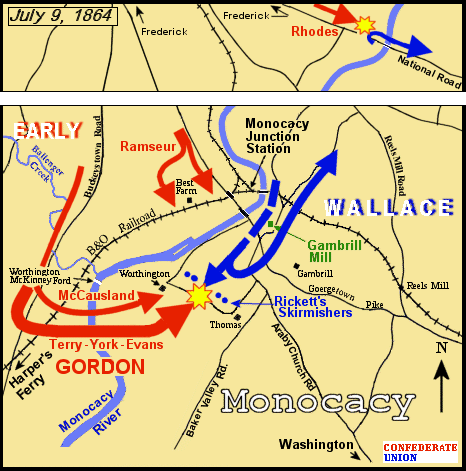
Moving down the Georgetown Pike, near the Best Farm, Confederate Major General S.
Dodson Ramseur's division encountered Union troops at the Monocacy River bridge.
On the National Road Major General Robert E. Rodes's
division also clashed with the Federals near the long bridge. Not wanting to risk
a direct attack across the river, Early sent Brigadier General John McCausland's
cavalry down Buckeystown Road to find a ford and outflank
down Buckeystown Road to find a ford and outflank the Union line. As a result, the
Confederates crossed the river below the McKinney-Worthington Ford and attacked
Wallace's left flank the Union line. As a result, the
Confederates crossed the river below the McKinney-Worthington Ford and attacked
Wallace's left flank . Heavy fighting occurred where the
Confederates encountered Rickett's veterans on the Thomas farm. . Heavy fighting occurred where the
Confederates encountered Rickett's veterans on the Thomas farm.
The Federals fought fiercely to hold position, but were pushed back by a three-
pronged attack of Confederates from Major General John B. Gordon's Division led
by Brigadier General William Terry, Brigadier General Zebulon York, and Brigadier
General Clement A. Evans.
The Federals, retreating toward Baltimore, left behind 1,294 dead, wounded or
captured.
The next morning the Confederates resumed their march on Washington. They had won
the battle but it cost them 700 to 900 killed and wounded, and delayed them a
day.
By June 12th, the Confederates were at Fort Stevens inside the District of Columbia,
but their visit to Washington, D.C. was short-lived. The arrival of General H. G.
Wright's Corps forced Early to withdraw across the Potomac River and ended any
prospects for the Confederates taking Washington. inside the District of Columbia,
but their visit to Washington, D.C. was short-lived. The arrival of General H. G.
Wright's Corps forced Early to withdraw across the Potomac River and ended any
prospects for the Confederates taking Washington.
CONCLUSION
The Battle of Monocacy is called the battle that saved Washington. It did save
Washington, but not alone. Any of the other delaying events that occurred during
Early's month-long march from Richmond to Washington, could also have been
credited with saving Washington. However, the battle of Monocacy was the only
action, during Early's raid, that was specifically intended to delay the
Confederates, and, in that, the Federals were successful.
(Text Source: U.S. Gov't, National Park Service and various others.)
|
|
PAGE TWO
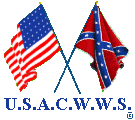 >
Civil War Photos
>
Monocacy
>
Page 2
>
Civil War Photos
>
Monocacy
>
Page 2
|
|








